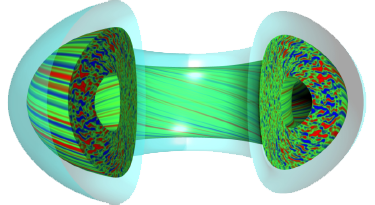Speaker
Description
The analysis of thermal events on the components of fusion reactors is of major importance, both from a machine protection and from a science standpoints. This analysis, which can be conducted using infrared cameras placed inside the reactor [1], ought to be transferred from human operators to automatized processes because of the quantity of data involved and the need for real-time analysis. Hence, there is a need for an automated pipeline able to detect and classify thermal events, either for feedback control of the injected power during plasma operation, or for later analysis. The paper presents a multi-stage algorithm which aims at detecting, tracking and classifying thermal events automatically using thermal imaging of the inside of the fusion reactor as well as other relevant signals.
The first stage of the pipeline is the detection of the hot spots in infrared images: it is carried out, one frame at a time, by the Cascade R-CNN algorithm [2], implemented using PyTorch by Facebook AI in Detectron2 [3]. The inference speed reaches 30fps on a high-end laptop equipped with a GPU, making this approach compatible with real-time monitoring. Once the hot spots detection has been performed in each image, thermal events are inferred by matching and tracking the hot spots in time, using the real-time tracking algorithm SORT [4].
The second stage of the pipeline is the classification of the detected thermal events according to a defined ontology. This step is crucial since it will dictate the response of the feedback system, that will react based on the criticality of the classified event. The classifier relies on the detected thermal events (from the first stage of the pipeline) as well as on signals from other diagnostics, such as the plasma current or the power injected in the reactor.
The model is trained, validated and tested using a database of 1325 manually annotated thermal events from a divertor-facing infrared camera of the WEST fusion reactor, a tokamak located in Cadarache, France, right next to ITER. The first stage of the model (the detection) reaches a mean average precision mAP@50% of 84.3% on the test set. Other criteria quantifying the performance of the pipeline are introduced in the paper. These encouraging results motivate the creation of another database of manually annotated thermal events from different types of cameras (wide-angle, antennas…), and show the potential for a real-time wall monitoring system, able to automatically detect and classify thermal events and to trigger feedbacks during plasma operation (for instance by reducing the power injected by an antenna if a local overheating has been detected).
[1] X. Courtois, M. H. Aumeunier, C. Balorin, J. B. Migozzi, M. Houry, K. Blanckaert, Y. Moudden, C. Pocheau, A. Saille, E. Hugot, M. Marcos and S. Vives, “Full coverage infrared thermography diagnostic for WEST machine protection,” Fusion Engineering and Design, vol. 146, p. 2015–2020, 9 2019.
[2] Z. Cai and N. Vasconcelos, “Cascade R-CNN: High Quality Object Detection and Instance Segmentation,” 24 6 2019.
[3] Y. Wu, A. Kirillov, F. Massa, W.-Y. Lo and R. Girshick, Detectron2, 2019.
[4] A. Bewley, Z. Ge, L. Ott, F. Ramos and B. Upcroft, “Simple online and realtime tracking,” in 2016 IEEE International Conference on Image Processing (ICIP), 2016.
| Country or International Organisation | France |
|---|---|
| Affiliation | CEA/Cadarache (IRFM) |

